
Catalog excerpts

by Richard A. Caldwell Reichhold* onventional solvent-based oil-modified urethanes (OMU) have been a mainstay in wood flooring and clear varnish applications for many years. Since their introduction into the United States in the early 1950s, their usage has grown steadily. They find application in the toughest environments, like gymnasium and athletic floors, as well as clear varnishes for hardwood floors in homes, offices, and other public buildings. While favored by the professional flooring contractor, they also are used by the do-it-yourself (DIY) homeowner, for everything from floors to cabinet refinishing to wood furniture restoration. The features that have made this technology so popular over the years include ease of application, fast dry, excellent long-term durability, and reasonable cost. There are very few resin and varnish systems that can provide the ease of use, appearance, dry time, early mar and scuff resistance, abrasion resistance, and household stain and chemical resistance of a solventborne oilmodified urethane varnish. Currently, conventional solvent-based oil-modified urethanes, with all of their features and benefits, are facing extinction in the marketplace. The cause: implementation of volatile organic compound (VOC) regulations. The top performing solvent-based oil-modified urethanes have a hefty 520–550 gram/liter VOC. Regulations that will take effect in the northeastern United States in 2005 and in the Los Angeles area of California in 2006 call for VOCs of 350 g/L and 275 g/L, respectively. Questions that are addressed in this article include: (1) What is an oil-modified urethane, and why is it so popular for wood floor coatings? (2) What are the VOC regulations? When do they take effect? Presented at the 82nd Annual Meeting of the Federation of Societies for Coatings Technology, October 27-29, 2004, in Chicago, IL. *P.O. Box 13582, Research Triangle Park, NC 27709; E-mail: rick.caldwell@reichhold.com.
Open the catalog to page 1
Technology Today (3) What test methods were used to determine alternative technology performance? (4) What are the alternatives to solvent-based OMU technology? (5) How do the alternatives compare to the best of the solvent OMU technologies (550 g/L)? (6) Is oil-modified urethane technology doomed to extinction, or do the VOC-compliant alternatives provide an opportunity for distinction? SOLVENTBORNE OIL-MODIFIED URETHANES Applications Solventborne oil-modified urethanes are used extensively in the wood floor finish market. Wood floor finishes range from gym floors, which are typically...
Open the catalog to page 2
Figure 2—Oxidative cure model of oil-modified urethanes. OMUs, could add slightly more color in both the wet varnish and dry film. Manganese gives more of a through-dry and is slightly lower in overall color than cobalt. If very rapid cure is required (to get faster backin-service times), an accelerator can be used. Examples of accelerators are commercial products DriRx and Activ8. Optimum use levels for accelerators are a 1:1 molar ratio of accelerator to drier metal. The 1:1 molar ratio, for varnish formulation purposes, is approximately 12 times the weight of pure metal in the drier....
Open the catalog to page 3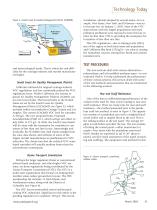
Technology Today Figure 3—South Coast Air Quality Management District (SCAQMD). mendation, already adopted by several states—for example, New Jersey, New York, and Delaware—was set to become law on January 1, 2005. Most of the OTC states (those with the largest populations and most pollution problems) were expected to have this law in place by that time. OTC is providing the exemption for containers of less than one liter. The OTC regulations—due to timing (early 2005); size of the region in both land mass and population; and California-like limit (350 g/L)—are what is causing the immediate...
Open the catalog to page 4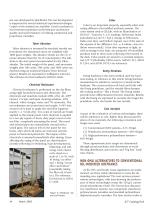
test was developed by Reichhold. The test development is supported by several statistical experimental designs. Copies of the method are available. Good correlation is seen between pendulum scuff resistance and known quality and scuff resistance of existing commercial and proprietary varnishes. Taber Abrasion Taber abrasion is measured by standard varnish test procedures: the instrument arms are weighted with 1000 gram weights. The abrasive wheels are the CS-17 (more abrasive than the CS-10 counterparts). The substrate is the steel panel recommended for the Taber abrader. The initial weight...
Open the catalog to page 5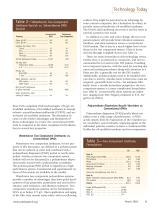
Technology Today Table 2—Waterborne Two-Component Urethane Varnish vs. Solventborne OMU Varnish Property Waterborne Two-Component three VOC-compliant OMU technologies: 350 g/L oilmodified urethanes; oil-modified urethanes in exempt solvent—parachlorobenzotrifluoride (PCBTF); and water-based oil modified urethanes. The discussion focuses on the relative advantages and limitations of those technologies. In review, the conventional OMU resin is compared to the three compliant OMU alternatives in several key properties. Waterborne Two-Component Urethanes vs. Conventional OMUs Waterborne...
Open the catalog to page 6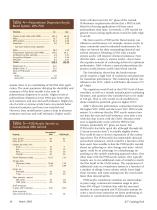
Table 4—Polyurethane Dispersion/Acrylic Blend System, 40% PUD Materials system, there is no crosslinking of the film after application. The main parameter dictating the durability and resistance of the final varnish is the ratio of polyurethane dispersion to acrylic. Higher levels of polyurethane dispersion (over 50%) give better abrasion resistance and mar and scuff resistance. Higher levels of acrylic or styrene acrylic latex can provide better chemical resistance and lower raw material cost. However, latex modification causes a drop in abrasion resistance and mar and scuff resistance....
Open the catalog to page 7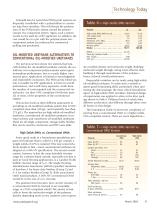
Technology Today It should also be noted that PUD/acrylic systems are frequently crosslinked with a polyaziridine in contractor type floor varnishes. This will elevate the performance of the PUD/acrylic system toward the polyisocyanate two-component system. Again, such a system would not be used by a DIY applicator. In addition, the cost would be on a par with the polyisocyanate twocomponent system (as evidenced by commercial polling and purchases). OIL-MODIFIED URETHANE ALTERNATIVES TO CONVENTIONAL OIL-MODIFIED URETHANES The previous section shows two systems that basically bracket the...
Open the catalog to page 8All Reichhold catalogs and technical brochures
-
UROTUF® F275-M-75
2 Pages
-
EPOTUF® 38-698
2 Pages
-
F600-W-40
2 Pages
-
UROTUF®
7 Pages
-
DION® IMPACT 9133
2 Pages
-
UROTUF® Water-borne Urethane
4 Pages
-
BioiPreferred® Guideline
2 Pages
-
NORPOL® ULTIMATE GELCOAT
2 Pages
-
NORPOL® SVX Gelcoat
2 Pages
-
NORPOL® SVG Gelcoats
3 Pages
-
NEW NORPOL® SRG GELCOAT
2 Pages
-
DION® Corrosion Guide
45 Pages
-
POLYLITE ® 3354225
3 Pages
-
EPOTUF® 38-698
2 Pages
-
Improved vinyl ester technology
21 Pages
-
UROTUF® F600-W-40
2 Pages
-
UROTUF® E300-W-40
2 Pages
-
Corrosion Guide
45 Pages
-
Coating Resins Catalog
35 Pages
-
BECKOSOL AQ®
12 Pages
-
AROFLINT® Flyer
2 Pages
-
Material Selection Guide
77 Pages
-
FRP Inspection Guide
36 Pages
-
Vacuum Foil Infusion
19 Pages
-
RTM Light
15 Pages
-
Pultrusion (Europe)
3 Pages
-
A Reichhold Company Overview
11 Pages
-
NORPOL® VBC Barriercoat
3 Pages
-
NORPOL® GI
3 Pages
-
NORPOL® CPG
4 Pages
-
Pultrusion (EMEA)
3 Pages
-
NORPOL® SVG Gelcoats
4 Pages
-
Fire Retardant (EMEA)
15 Pages
-
Bonding Paste (EMEA)
15 Pages
Archived catalogs
-
Vacuum Foil/ RTM Process (EMEA)
11 Pages
-
Tooling System (EMEA)
11 Pages
-
SMC/ BMC (EMEA)
3 Pages


























































